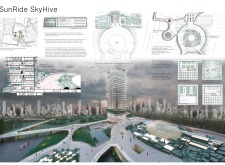5 key facts about this project
The SunRide SkyHive project presents a thoughtful and practical approach to address the social and environmental issues in Venustiano Carranza, Mexico City. It combines several functions, including urban agriculture, workshops, and recreational spaces. The design aims to enhance community well-being while promoting sustainable practices through the integration of various elements that work together for a common purpose.
Harvest Greenhouse
At the heart of the SunRide SkyHive is the harvest greenhouse, which local residents operate as part of gardening workshops. This greenhouse plays a vital role in food production, allowing community members to grow and sell crops at a market located on the first floor. The initiative fosters self-sufficiency and strengthens the local economy by linking agriculture with commerce, creating a space where people can actively engage in their food sources.
Energy Generation
The energy generator circuit forms an essential part of the building’s design. Solar panels mounted on the facade serve to capture sunlight, augmented by solar photocells that contribute to energy gathering. This method of energy generation reduces reliance on outside sources. It allows the building to produce its own power, supporting sustainability while working toward lower carbon emissions.
Recreational Integration
The design includes bike lanes and running paths that connect different recreational parks. These pathways encourage outdoor activities and physical exercise within the community. The connection between these spaces supports social interactions among residents. The proposed green rooftops atop TAPO’s modules not only enhance the building's appearance but also contribute positively to the environment.
Interior Biophilic Design
Inside the SunRide SkyHive, double-height spaces feature hanging gardens that introduce greenery into the indoor environment. This design choice significantly improves air quality and creates a more pleasant atmosphere for users. The integration of nature inside the building contributes to the overall experience, making the space feel alive and connected to the surroundings.



















































